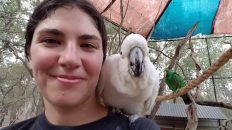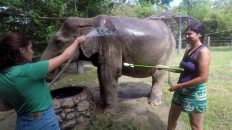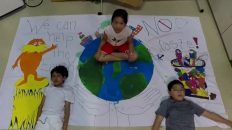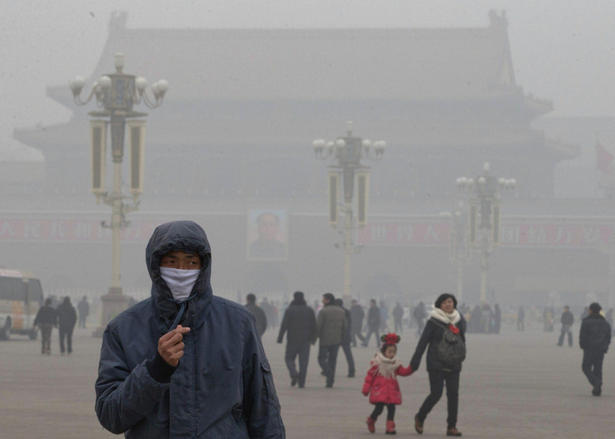 In this vlog post I will be discussing the air quality in China. Since they burn a lot of coal for energy, plus there are a lot of factories, as well as people, this creates something called smog, or air pollution. I had seen on TV videos and pictures of people wearing surgical masks, and walking around in a gray haze, but it is a whole different experience when you are in the pollutive fog yourself.
In this vlog post I will be discussing the air quality in China. Since they burn a lot of coal for energy, plus there are a lot of factories, as well as people, this creates something called smog, or air pollution. I had seen on TV videos and pictures of people wearing surgical masks, and walking around in a gray haze, but it is a whole different experience when you are in the pollutive fog yourself.
I have always enjoyed being in nature more than a place like New York City. The city is loud and full of people, but I often go there to meet friends, take classes, see shows, and go to Central Park. Beijing is similar to NYC because it is also loud and full of people, but it has historical places like the Forbidden City. Beijing also has a LOT of smog.
For the 4 days I was in Beijing, I never saw the blue sky. It was so hard to breathe – when I inhaled, I had to take big, deep breaths through my mouth. When I would breathe through my nose, I couldn’t get enough air – plus it smelled like smoke and trash a lot of the time. One of my friends that I am teaching with got extremely sick from the Beijing air and didn’t teach the first week of school – he was coughing heavily, and his lungs and throat were sore for more than a week after.
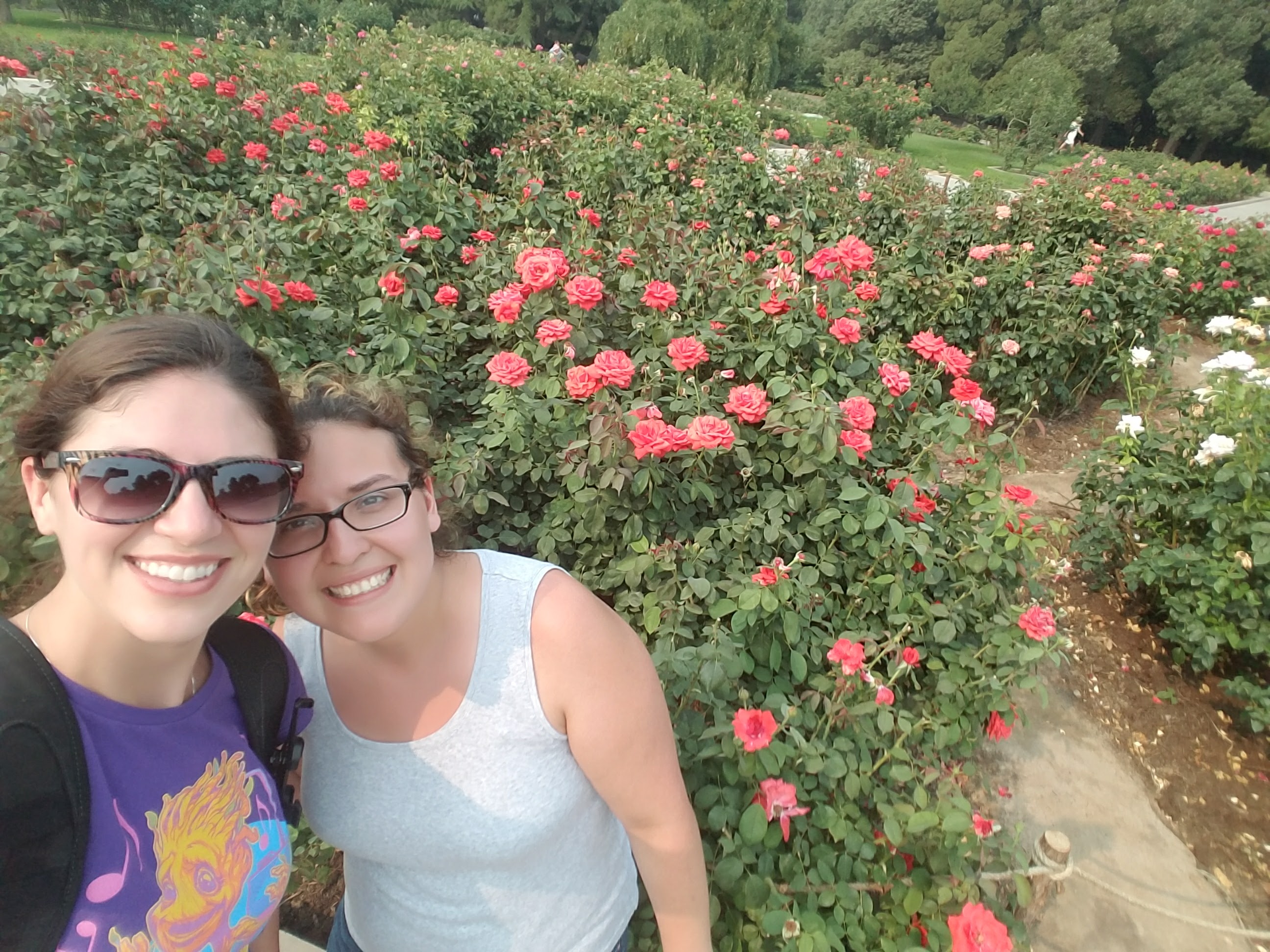 Then I went with my friend Kat to the Temple of Heaven. This is a gorgeous garden sanctuary in the middle of a smoggy city. As soon as I walked in and saw all the trees, I breathed easier – inhaling through my nose was not as painful or gross as walking through the city. It was a stark difference – not only did it smell significantly better, but being away from the cars, noise, trash, and pollution significantly recovered my lungs and eased my breath.
Then I went with my friend Kat to the Temple of Heaven. This is a gorgeous garden sanctuary in the middle of a smoggy city. As soon as I walked in and saw all the trees, I breathed easier – inhaling through my nose was not as painful or gross as walking through the city. It was a stark difference – not only did it smell significantly better, but being away from the cars, noise, trash, and pollution significantly recovered my lungs and eased my breath.
Now, there is smog all over the world, just not as apparent or extreme. Cities like Athens, Greece, London, England, Los Angeles, California – all experience the detrimental effects of globalization and industrialization. In Beijing, smog gets so bad, especially around winter (when they’re burning a LOT of coal for heat) that schools get shut down, people are told to stay indoors, and plants and animals die.
You may think: What can I do to change this? China is so far away, this won’t affect me, and I can’t help people who live thousands of miles away.
Now, go take the closest item near you, and look where it is made from. Does it say ‘Made in China’?
We need to take responsibility, because when we realize our consumption is part of the problem, only then will we be able to work together to find the solution.
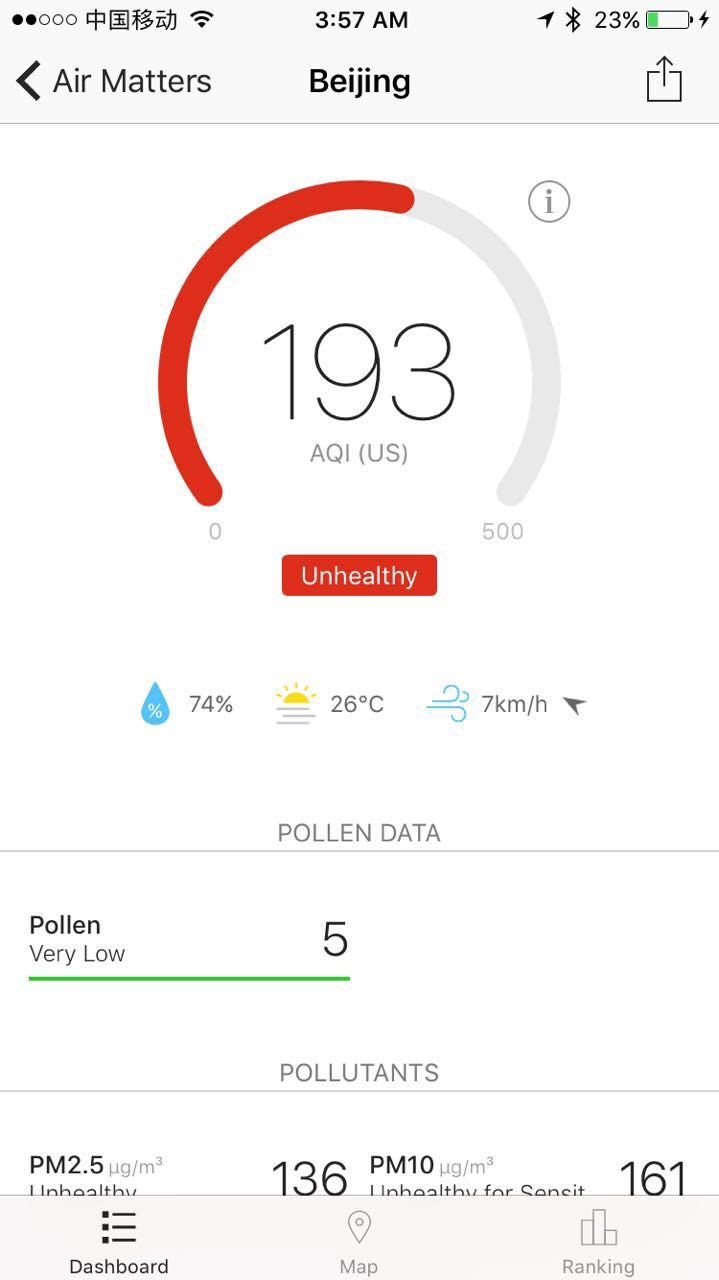 One solution that we can use is technology. There is always an app for something, and in China, I found out about this app called “Air Matters”. Whether you are in China, or elsewhere in the world, you can download the app. This app has scores for air quality – the lower the number, the better the air quality. It also shows levels of pollen, oxygen, nitrogen, and PM levels.
One solution that we can use is technology. There is always an app for something, and in China, I found out about this app called “Air Matters”. Whether you are in China, or elsewhere in the world, you can download the app. This app has scores for air quality – the lower the number, the better the air quality. It also shows levels of pollen, oxygen, nitrogen, and PM levels.
PM levels are particulate matter levels, which are very bad for your lungs. On Air Matters, they show the PM 10 and PM 2.5 levels – these numbers identify the size difference in the particles (PM 2.5 being smaller). When PM levels are high, that increases the risk of cancers, asthma, and various other diseases. This is because PMs (especially PM 2.5) are small and go into your major organs, like your lungs, heart, and liver, and cause permanent damage. Air pollution affects everyone, especially children.
To learn more about smog, check out this article from National Geographic: https://www.nationalgeographic.org/encyclopedia/smog/
In this post, I am including a smog lesson taken from Broward County’s website, which is in Fort Lauderdale, Florida. They have an amazing website for their constituents, with pages dedicated to educating children on the world around them. I highly suggest going to their website and seeing the amazing Lorax-inspired activities and clubs they have!
The reason I choose this lesson is because it is interactive and visually stimulating. It will definitely increase your students, children, and your consciousness of your individual energy impact. This is a very high academic lesson, so I will be adding my differentiation of the lesson in green.
If this lesson benefits you and your classroom in any way, I would really love to know! You can message me through the “Contact” section, and/or please fill out this 4 question survey.
Some books I would use with this lesson would be: Uno’s Garden (by Graeme Base) and How to Help the Earth By The Lorax (by Trish Rabe).
 Air Quality Lesson
Air Quality Lesson
Background: Each of your students begins the demonstration with a cup of clean water representing unpolluted air. During the demonstration, you’ll read them 6 everyday activities. Each of the activities generates one or more of the pollutants listed below. When your students recognize an activity that they have participated in, they add a drop of food coloring to their cups to represent the pollutant or pollutants created by that activity. At the end of the demonstration, their cups of colored water provide a striking visual reminder of each student’s contribution to air pollution.
Familiarize yourself with the pollutants in the list below so that you can explain them to your students during the demonstration.
Particulate matter (PM10)—Particulate matter consists of airborne solids less than 10 micrometers in diameter. These tiny particles are easily inhaled into the lungs, where they can cause damage to lung tissue. Diesel fumes from busses and trucks are a source of airborne particulate matter.
Sulfur dioxide (SO2)—Sulfur dioxide is a toxic gas with a pungent odour. Electric power plants fuelled by coal or oil are the primary source of sulfur dioxide pollution. Sulfur dioxide emissions can cause respiratory diseases and are a key factor in acid rain formation.
Nitrogen dioxide (NO2)—Nitrogen dioxide is a toxic, reddish brown gas by product of the combustion of fossil fuels (e.g., coal, diesel fuel, and gasoline). Nitrogen dioxide can irritate airways and increase susceptibility to respiratory diseases. It is also a factor in the formation of acid rain.
Carbon monoxide (CO)—Carbon monoxide is a colourless, odourless toxic gas. Motor vehicles are the primary source of carbon monoxide pollution. CO is highly toxic. At low concentrations it causes drowsiness and headache; it is lethal in high concentrations.
Volatile organic compounds (VOCs)—Volatile organic compounds are toxic gases made of carbon, hydrogen, oxygen, and other atoms that form gases easily. They are found in nature as well as in glue, paint, gasoline, tobacco smoke, and clothes that have been dry-cleaned. VOCs form ground level ozone, a main component of smog.
These are great science vocabulary words for higher-level thinkers. When I teach this lesson to my students (3rd/4th grade special needs) I would identify all these as “smog” or “air pollution” to simplify it. I would explain that smog hurts the body in many ways, especially how you breathe. Our classroom already has ‘breathe’ as a vocabulary word from The Bubble Game, which I would reference, and I would also include ‘reduce’ (because we want to reduce our pollution impact, and the smog in the air), as well as ‘smog’ and ‘air pollution’.
The Activity
“We are often unaware of how our everyday activities contribute to air pollution. The purpose of this demonstration is to make you aware of the air pollution you create every day. The cup of clean water in front of you represents unpolluted air. You’ll add drops of food coloring to the cup to represent the different types of air pollutants caused by the everyday activities that I’ll describe to you.
We’ll use the following colors to represent these pollutants: Color Key Blue—pollutants from consumer products and paints (VOCs) Green—pollutants from lawn, garden, and construction machinery (CO, NO2, PM10, SO2, and VOCs) Red—pollutants from cars and trucks (CO, NO2, PM10, SO2, and VOCs) Yellow—pollutants from power plants and industrial processes (CO, NO2, PM10, SO2, and VOCs)
I love using food coloring, and identifying colors is one of the many goals for my students to master when in my classroom. However, I would not identify the pollutants (again, those wouldn’t be vocabulary words I teach in my room) but I would have them identify the colors and explain that different forms of pollution have a different impact.
Listen carefully while I describe the following activities. If you participated in the activity during the past 24 hours, add one drop of the appropriate color of food coloring to your cup of water. Some activities may not apply to you (for example, applying nail polish or mowing the lawn). That’s why you each have your own cup, because each individual’s contribution to air pollution is unique.
- You showered and got ready for school. Add one drop of blue and one drop of yellow food coloring to your cup if this activity applies to you. Blue—VOCs emitted by soap, shampoo, deodorant, hair spray, perfume, and fingernail polish. Yellow—CO, NO2, PM10, and SO2 emitted by combustion used to heat the water for the shower. Remember, electric water heaters often depend on combustion too, because a lot of power plants burn fossil fuels to generate electricity.
I would separate each color as a step. So I would say “Add one drop of blue if you took a shower last night or this morning. This blue represents the soap you used to clean your body. Now, add one drop of yellow if you took a warm shower – this is because when you make the water hot, you burn fossil fuels.” If you look at the last sentence, I would reword it like this: “When you take a warm shower, you use water, and you use electricity when you make the water hot. When you make the water hot, you are burning something called ‘fossil fuels’ which creates air pollution.”
- You put on your favorite shirt, which your mom had dry-cleaned for you. Add one drop of yellow food coloring to your cup if this activity applies to you. Yellow—VOCs emitted by the dry-cleaning process.
I would not include this step, because not only can my students not explain what ‘dry-cleaning’ is but they also would not have a family that dry cleans their school clothes.
- Coming to school, you took the bus or rode in a car. Add one drop of red food coloring to your cup if this activity applies to you. Red—CO, NO2, PM10, SO2, and VOCs emitted by the engine in your school bus or car.
This would definitely be included – all my students get transportation to school. So I would say “Add one drop of red if you took a bus, van, or car to school. This red is the gas that comes from the car.”
- At lunchtime, you bought lunch in the cafeteria. Add one drop of yellow food coloring to your cup if this activity applies to you. Yellow—CO, NO2, PM10, SO2, and VOCs emitted by cooking lunch, Styrofoam trays, and plastic utensils.
All of my students receive free or reduced breakfast and lunch. So I would say “Add one drop of yellow if you ate breakfast today. Add one more drop of yellow if you ate lunch today. This yellow comes from the smoke made by our cafeteria workers to make our meals, and it also represents all of the things we use to eat our meals, such as our Styrofoam trays, plastic spoons, and cups.”
- Going home, you took the bus or rode in a car. Add one more drop of red food coloring to your cup if this activity applies to you. Red—CO, NO2, PM10, SO2, and VOCs emitted by the engine in your school bus or car.
- You mowed the lawn with a gasoline-powered lawnmower. Add one drop of green food coloring to your cup if this activity applies to you. Green—CO, NO2, PM10, SO2, and VOCs emitted by your lawnmower’s engine.
I may or may not include this step – most of my students do not have front or backyards, and would not be entrusted to use a lawnmower. Depending on the season, and the day, I would ask the students to add a drop of green if they saw or heard someone use a leaf blower, or lawn mower, or snow blower. Our school has a beautiful backyard, and twice a week landscapers come to mow the lawn, pick up trash, and blow debris away from the field and walking area. I would have the students take a video, or go outside for a short observation of the workers.
Discussion: Ask your students the following questions: Look inside your cups. If the air pollution around you were this apparent, would you want to breathe the air? What other sources of air pollution, beyond those mentioned in this demonstration, could you think of as being produced in a single day? What could you do to reduce the number of pollutants released each day? If you have a container large enough, ask your students to pour their water into it, and then ask them to comment on the combined effect of each individual’s pollution.
Along with a discussion about smog and air pollution, I would have students draw their cups before and after the air pollution experiment. I would also ask them to draw their interpretation of smog, and show my journal pages (Sarah Beijing Illustration – 05-Jul-2017, 21-20) as examples.</span


